Flex-packs on the cutting edge
"Technology is not an image of the world but a way of operating on reality."–Octavio Paz.
Technological triumphs in flexible packaging won big this year at the 2004 Flexible Packaging Achievement Awards, sponsored by the Flexible Packaging Association. Announced in February at FPA's annual meeting in Naples, FL, the winners are heavy on technology in both form and function. Some incorporate "first-of-a-kind" technologies, such as for the healthcare industry, with advancements like a single-dose pouch applicator with a frangible seal and an easy-peel formed pouch with a built-in desiccating sealant film. Both offer critical protection for patients while delivering effectiveness and security for healthcare providers.
Other winning entries have either received or are awaiting patents for their breakthrough processes and/or structures, such as a business-card-sized package created as a sanitary, precise delivery sampler for cosmetics.
Winners represent new ways to present and protect while exceeding performance standards throughout distribution. And advanced printing and converting processes abound this year in the futuristic look and feel of several new flexible packs for consumer applications from socks to electronics, that present stunning, intricately printed, realistic graphics, finishes, special printing techniques, brilliant metallized laminations and breakthrough, in-line demetallizing effects.
Out of a record-setting 126 entries, 28 packages received 36 gold, silver or highest achievement awards in four categories–packaging excellence; printing; technical expertise; and environmental significance. With so many winners, PD will cover the Printing Achievement awards in our April Labeling & Decorating issue and is featuring five of the silver award winners exclusively on our website, packagingdigest.com.
For a fourth year in a row, two packages have been awarded the coveted Highest Achievement Award–one in the institutional sector and the other in the retail sector.
Highest Achievement
Winning one of two Highest Achievement awards is the Del Pouch (1), developed by Pechiney Plastic Packaging for healthcare products provider Cardinal Health, Philadelphia, for difficult-to-contain ointments, lotions and creams. This single-dose applicator has a frangible, or readily or easily broken, seal. Not much has changed about the package since PD last reported that it also won a special citation in the DuPont Awards in August, 2003 (see PD, Sept.'03, p. 48), according to Pechiney's packaging engineer, James Sikorsky.
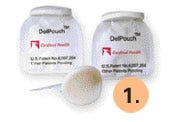 The Del Pouch can be compressed, which fractures the weaker seal and allows the product inside to escape into a foam applicator pad for a single-dose application. The seal, coupled with the foam applicator, delivers contents in a sanitary way, without the risk of contamination.
The Del Pouch can be compressed, which fractures the weaker seal and allows the product inside to escape into a foam applicator pad for a single-dose application. The seal, coupled with the foam applicator, delivers contents in a sanitary way, without the risk of contamination.
A hybrid multilayer package structure that Pechiney considers an adhesive lamination, the pouch was in development about one year. It's produced with an outer layer of polyester produced in a single-pass extrusion process to achieve heat-resistance. Overall pouch structure is described as (from the outside) surface flexo print/48-ga polyethylene terephthalate/white PE extrudate/35-ga foil/adhesive/48-ga PET/adhesive/2-mil high-barrier frangible coextruded sealant film. Thickness is approximately 5.25 mils.
Sikorsky explains that the sealant technology is the backbone behind the pouch concept, as it allows Cardinal to weld-seal three of the four seals at high temperatures and seal the fourth at a much lower temperature, which allows it to be peelable. Temperature, he says, can be used to control the opening of the seal.
"The type of sealant is peelable–what we call a contamination peel, made with specific additives to promote incompatibility between the materials, so that when they're sealed together, peel force is controlled."
The purpose of the sealant film is twofold, Sikorsky reports. First, the barrier layer ensures that hard-to-hold ointments can be securely contained while the second purpose of the sealant film is to offer the frangible opening feature, which is key to overall package performance, he says.
"A frangible seal was needed in Cardinal's case to break under pressure, but it is able to contain aggressive products," Sikorsky tells PD. "The sealant layer also allows the pouch to be filled and sealed with no loss of product. Once the contents are used, the empty pouch can be discarded; the user never has to touch the product contents."
In a market dominated by flexible tubes, rigid vials and plastic bottles, the single-dose flexible pouch offers similar shelf-life requirements, Sikorsky says, and is an excellent example of the marriage between cutting-edge machine and film technology.
Having a protective layer of PET incorporating the frangible barrier sealant film, the Del Pouch can also be used for products such as alcohol and iodine and pharmaceutical creams, in addition to aggressive ointments.
Bruce Detwiler, new product development engineer at Cardinal Health, tells PD that the foam applicator pad is key to this unique package technology. "This pouch technology can accommodate products with the viscosity of a liquid and the specific gravity of one, all the way up to 100,000 centipoise, by varying the foam applicator, which is key for expressing the different viscosities. For something watery, we use a denser [foam] material and for something like toothpaste, we could use a felted, nonwoven material."
Detwiler says that Cardinal is developing the Del Pouch for various applications, including cosmetics, OTC healthcare products, skincare products, dental hygiene products, prescription dermatological products and more. The portable pouch travels well and can be used to treat cuts and burns with a single dose and then be discarded. The package can be produced in two sizes–one that expresses 1/2 g of product and the larger pouch that expresses 1 g.
Cardinal commercially fills the pouches in Puerto Rico using custom machinery built by Harro Höefliger to die-cut and seal the sides and fill the unique frangible laminated-film rollstock. The filling process meters exact amounts of product and injects the product into the pouch opening. In the final stage, a foam applicator pad is heat-sealed by the Höefliger machine to the pouch, producing a single-use applicator. The pouch may be gravure-, flexo- or screen-printed with very fine type. Circle No. 214
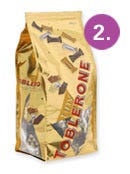 Demetallizing opens windows for Toblerone
Demetallizing opens windows for Toblerone
A glittering standup pouch for Kraft Foods' Tiny Toblerone individually wrapped chocolate miniatures (2) won the second Highest Achievement as well as a gold award in Environmetal Achievement for Amcor Flexibles. Aimed at the duty-free market worldwide, the new package is produced using Amcor's exotic DeMetXP golden metallized film, which Amcor makes with several highly transparent windows that create the pouch's luxurious look. The 300-g standup pouch is made with a gusseted, quadro-seal, or "stabiloseal," in Switzerland using an adhesive lamination of 20-micron transparent biaxially oriented polypropylene/20-micron vacuum-metallized BOPP rollstock 220-mm-wide (8.66142 in.).
Amcor Transpac Halen in Belgium converts and demetallizes the pouch material. Reverse-gravure-printed in six colors, the glittering gold pouch utilizes a revolutionary, proprietary in-line demetallization process accomplished on specially modified printing systems to achieve clear film windows through which the individually wrapped chocolates can be seen. Described as both efficient and environmentally friendly, the DeMetXP technology not only took top honors, but also won gold awards for technical innovation, printing achievement and environmental achievement.
The technology was in development approximately two years. During demetallization, the metal layer is not removed from the substrate metal, but instead, is chemically treated with a unique demetallizing agent that reacts with the metallic layer to create the glass-clear triangular windows.
Guy Grossard, product manager for Amcor Flexibles Transpac, explains that the demetallization process is unique not only because it's performed in-line,but also because the metal layer is removed in a specialized chemical reaction process. "Printing and demetallization approval are done simultaneously and immediately," he says. "The metal layer isn't washed away, but instead becomes transparent as a result of a well controlled chemical reaction. Any demetallization problem can be observed immediately, and corrective action can be taken."
Grossard says that traditional demetallizing processes usually require the application of a protective layer in the areas not to be demetallized. Thus, all other areas would be attacked by the demetallizing lacquer, as well as the cold seal. He says this isn't the case with DeMetXP technology, which allows demetallized cold-sealed packaging to be produced efficiently.
Since Toblerone chocolate bars are triangular in shape, the triangular windows blend well with the brand's theme.
A sweet pairing between inner wrappers and outer pouch is a striking metallic gold background and red and gold color scheme, with a bright red Toblerone brand logo that runs vertically up the front panel. The package has plenty of visual appeal, but the rigidity of the pouch is also noteworthy for its own stylish design. Graphics appear on the pouch's four main panels. The pouchstock is vertically sealed on four sides and lap-sealed in the back.
The DeMetXP process is capable of producing film windows of any size and shape, Grossard adds. He goes on to say that the new demetallization process eliminates the need for dirty wastewater, reduces waste material and can lower leadtimes, which also can end certain issues associated with conventional demetallization processes. Immediately visible during the printing process, the demetallization process can be assessed in real time.
Special demetallization agents, inks and adhesion-promotion coatings are used in Amcor's process, and an in-line production method has been developed and optimized, Grossard notes. "This makes possible a demetallized flowpack (form/fill/seal pack) with cold-seal in reserve," he says. "Although this feature isn't included in the Toblerone Tiny bag, it is worth mentioning, since it's an important distinguishing feature of the concept."
Amcor's goal is to be able to use the demetallization technique on the widest range of substrates possible, so it can be used with many "commodity" substrates, rather than special grades, he adds. While both the unusual printing technology and the raw materials were developed by Amcor, the bag material was developed to run on any bagmaking machine without modifications. Circle No. 215.

Standup pouch socks it to you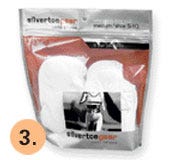 Gold Toe Brand's striking, contemporary standup pouch for Silvertoe gear® women's socks (3) was supplied by North State Flexibles LLC, which won a gold award for packaging excellence. Featuring a consumer-friendly reclosable zipper, less packaging, enhanced graphics and a dynamic retail presence, the new pouch can be merchandised vertically on a pegboard or upright on a shelf. The crisp, rigid look of the pouch is achieved through a structure of PET and clear linear-low-density PE, which also allows the inks to be buried, thereby offering a glossier, scuff-resistant, more durable package with greater point-of-purchase impact and an overall improved retail presentation. The rigidity provided by a structure consisting of 48-ga PET/ink/adhesive/4-mil clear LLDPE is a big improvement over the previous, unprinted bag.
Gold Toe Brand's striking, contemporary standup pouch for Silvertoe gear® women's socks (3) was supplied by North State Flexibles LLC, which won a gold award for packaging excellence. Featuring a consumer-friendly reclosable zipper, less packaging, enhanced graphics and a dynamic retail presence, the new pouch can be merchandised vertically on a pegboard or upright on a shelf. The crisp, rigid look of the pouch is achieved through a structure of PET and clear linear-low-density PE, which also allows the inks to be buried, thereby offering a glossier, scuff-resistant, more durable package with greater point-of-purchase impact and an overall improved retail presentation. The rigidity provided by a structure consisting of 48-ga PET/ink/adhesive/4-mil clear LLDPE is a big improvement over the previous, unprinted bag.
The reclosable zipper allows the consumer to easily open and close the package to feel the socks–considered an essential with soft goods. This feature also makes the package reusable after purchase. In addition, the elimination of the paperboard insert results in less packaging waste.
The reverse-flexo-printed film substrate replaces a two-side-printed paperboard insert in the unprinted bag. The inks were cleverly applied in one pass to provide a silver back panel and an orange inside panel that reinforces the design scheme and special custom colors critical to the marketing of Silvertoe gear socks.
Notes North State, this film package shows that flexography can compete effectively with offset printing of paperboard. Circle No. 216.
Corrosion-resistant bag protects rifles
Heritage Packaging, Valeron Strength Films and Cortec Corp. combined their design, converting, laminating and film production expertise to produce an innovative M-16 Rifle Preservation Bag (P/N HPV81503-M-16) for the U.S. Marine Corps that won gold awards for both packaging excellence and technical innovation (4). The new patent-pending bag design from Heritage Packaging features a reusable closure and a serial number window, enhanced serial number tracking capabilities and a considerable reduction of waste, while it significantly increases manual packaging speed. The package was submitted by Heritage Packaging and Valeron Strength Film.
The durable, user-friendly bag is made from a new laminated structure called Corrlam™ VpCI® barrier laminate, which offers unequaled anti-corrosion protection. An outer layer of Valeron® film provides enhanced puncture, abrasion resistance and strength, while the Cortec VpCI 126 LDPE sealant layer provides the anti-corrosion protection. By laminating VpCI-impregnated film to a metallic barrier layer, the VpCI molecules are trapped inside the packaging, providing unparalleled corrosion protection.
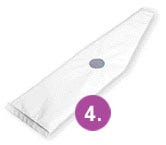 The U.S. Marine Corps solicited the development of a flexible packaging system that could replace existing methods of preservation packaging for anti-corrosion protection of refurbished M-16 rifles. The new system replaces weapon wraps of MIL-PRF-3420G paper heat-sealed inside a barrier bag. Heritage Packaging employed the use of the new two-ply laminate, developed together with Cortec Corp., as the body of the bag. This new material, known as Corrlam VpCI, is said to be the only flexible packaging laminate that provides excellent barrier properties as well as unequaled anti-corrosion protection (afforded by the VpCI sealant layer). Valeron Strength Films provides the outer layer of the lamination with its proprietary Use of one of Velcro USA's low-profile hook & loop closure systems also allows the bag to reclose easily while providing strength to prevent the weapon from inadvertently exiting the bag.
The U.S. Marine Corps solicited the development of a flexible packaging system that could replace existing methods of preservation packaging for anti-corrosion protection of refurbished M-16 rifles. The new system replaces weapon wraps of MIL-PRF-3420G paper heat-sealed inside a barrier bag. Heritage Packaging employed the use of the new two-ply laminate, developed together with Cortec Corp., as the body of the bag. This new material, known as Corrlam VpCI, is said to be the only flexible packaging laminate that provides excellent barrier properties as well as unequaled anti-corrosion protection (afforded by the VpCI sealant layer). Valeron Strength Films provides the outer layer of the lamination with its proprietary Use of one of Velcro USA's low-profile hook & loop closure systems also allows the bag to reclose easily while providing strength to prevent the weapon from inadvertently exiting the bag.
The patent-pending ArmorX CBP bag includes a clear viewing window that makes the weapon's serial number visible, and allows for quick and easy serial number verification. Packing speed is also increased from three rifles/hr to six rifles/min with the new system.
Manual insertion of the weapon and manual closure of the bag via the Velcro strips assure ample long-term protection from corrosion.
The bag's ease of use saves substantial labor at the packaging site as well as rapid redeployment of the weapon, if the need arises. Circle No. 225.
 Shrink bag keeps bones from penetrating
Shrink bag keeps bones from penetrating
The Curwood ArmorX CBP™ (Complete Boneguard Protection) shrink bag (5), which was recently introduced for large cuts of bone-in fresh pork and beef weighing up to 40 lb, won a gold award for packaging excellence and a silver award for technical innovation. The ArmorX CBP bag is an extension of Curwood's ABP™ (Absolute Boneguard Protection) product line. It minimizes bone punctures through the production and distribution cycle. A major advantage over ABP is that the protective bone-guard layer extends into the seal-header area of the bag.
Bone-in products have traditionally had high leaker rates, so there was a tremendous opportunity to reduce costs for the packer. Additionally, less fabrication is being done by butchers, so more bone-in products are being delivered "case-ready" to grocers. The bone-in bag is now the primary package the consumer sees in the cooler. The bag needs to have high shrink, and brilliant clarity and gloss, and must accommodate high-impact printing to properly market the product to the consumer.
CBP has higher shrink than the existing patch shrink bags, according to Curwood, and achieves a tighter fit and better appearance. The bone-in meat cuts arrive at the supermarket with a skin-tight package, which minimizes the loss of meat juices. The supermarket repackages the meat for retail display. Because there is a reduction in the amount of leakers, there is less waste. In fact, leaker rates have been reduced by up to 50 percent in field testing in extremely demanding applications.
The ArmorX CBP bag's unique two-ply construction comprises a continuous lamination of proprietary coextrusion blends that heat-seals easily and guards against bone punctures. Curwood coextrudes two webs, which are continuously laminated together. The shiny bag is also two-side register-printable, to accommodate high-impact graphics.
Patch bags have areas not covered by a patch, which makes them vulnerable to bone punctures. Curwood's ArmorX CBP bone-in shrink bags solve this problem. The ultra-tough multilayer coextrusion is laminated in a proprietary manufacturing process to create ArmorX™ Total Shield?#150;what Curwood says is the most effective protection against punctures available today.
Other technical innovations include the package's extreme toughness and ability to heat-seal well on high-speed rotary chamber machines running 40-lb packages at 20 pieces/min. One part of the manufacturing process is cross-linking, which is an irradiation process, where the film is exposed to low doses of radiation to widen its sealing characteristics. The polymers' properties are changed in this process, giving the film a wider operating window.
The film is made with a series of technologies including coextrusion, cross-linking for improved sealing, lamination and bagmaking. CBP has two webs continuously laminated together, compared to a patch, which is intermittently applied. The exact formulations of the webs are proprietary, but Curwood that confirms the coextrusions are high-end PE grades.
The inner ply is specifically designed to activate at lower seal temperatures and has a sealing window of +/- 30 deg F. Typical shrink products may only run in the +/- 10 to 15 deg F range. The highest concentration of puncture-resistance is placed where typical punctures occur–on the inside and outside film layers film.
The core layers are provide ultra barriers. All layers but one are PE-based, which is a polyvinylidene chloride (PVDC) oxygen barrier layer. The film is customized, depending on the nature of the product. The overall film thickness is 6.5 mils, but the thickness of each layer varies from 2 to 4 mils, depending on the cut of the bone-in product.
Curwood has applied for a patent for the formulations and the manufacturing process. The laminated structure is put through a bag machine, which produces end-seal bags with 100-percent total perimeter bone-guard protection. No edges are left exposed, so there are no vulnerable spots for punctures. The bags are produced in a focused shrink facility in Pauls Valley, OK. Circle No. 218.

Standup PE bag takes flight for chicken
Considered the first of its kind for frozen heat-and-serve chicken, a standup bag developed by Bemis Polyethylene Packaging Div. (PPD) for Brakebush Brothers' frozen chicken products (6) is a surface-printed PE package that's easy to open and reclose. Topped with a Hefty Slide-Ritew slider zipper 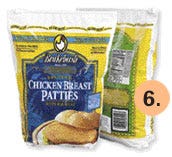 closure from Pactiv, the gusset-bottomed bag has a fill-through-the-gusset feature that Bemis PPD says allows the premade standup bag to be filled, sealed and trimmed on automated equipment, which can lower both manufacturing and distribution costs and make it easier to load the product.
closure from Pactiv, the gusset-bottomed bag has a fill-through-the-gusset feature that Bemis PPD says allows the premade standup bag to be filled, sealed and trimmed on automated equipment, which can lower both manufacturing and distribution costs and make it easier to load the product.
Replacing a pillow-pack, the slider-zippered bags were first introduced in early 2003. Bemis PPD says the new bags represent a significant technical achievement, as it considers the fill-through-the gusset feature an industry first for a PE bag.
Bemis PPD's facility in Terre Haute, IN, coextrudes the 3-mil glossy opaque white PE bagstock and surface-flexo-prints it using eight-color digital plates. Updated, highly detailed graphics include new product varieties and point out the Slide-Rite closure feature. The Terre Haute facility also produces the bags, forming the special gusset with an extra 1/2-in. lip of film across one side that allows the bag to be properly sealed.
Consumers like the Slide-Rite slider closure for its super convenience. Brakebush, Westfield, WI, adopted the slider closure so that consumers can easily use only the product they need at one time, reseal the bag without the need for additional ties, tape or bands and freeze the rest for later.
The bags are bottom-filled through the gusset. They hang on a wire wicket upside down so that air can blow them open, and the product can be dropped in. The bag is then sealed and trimmed.
Stackable and large enough for multiple servings, the standup bag holds 28 oz of various frozen chicken product varieties, including breaded Touchdown Nuggets and breaded Grilled & Seasoned Chicken Breast Patties. According to Bemis PPD, the durability of the bagstock allows the premade bag to protect the chicken portions from the elements of the refrigerator or freezer and cuts down on product and packaging waste.
PD is told that Brakebush bags the chicken products on a Doboy filler/sealer. Circle No. 219.
Kissable lip color sampler Despite the enormous competition, the ColorKiss lipstick applicator for Orlandi may have created a sanitary, tamper-evident delivery method for cosmetic sampling (7). Winning a silver award in packaging excellence for American Packaging Corp., the patented package is smaller in size than a business card but holds enough lip color for a single application in a "kissable" quantity. Developed for the sampler market, the film laminate construction is far more than just a sample representation of color, but acts as a tester, says Debby Pruismann at American Packaging Corp. "It's an application of lipstick in a hygienic and precise format," she says.
Despite the enormous competition, the ColorKiss lipstick applicator for Orlandi may have created a sanitary, tamper-evident delivery method for cosmetic sampling (7). Winning a silver award in packaging excellence for American Packaging Corp., the patented package is smaller in size than a business card but holds enough lip color for a single application in a "kissable" quantity. Developed for the sampler market, the film laminate construction is far more than just a sample representation of color, but acts as a tester, says Debby Pruismann at American Packaging Corp. "It's an application of lipstick in a hygienic and precise format," she says.
Containing one application of lip color in the shape of a pair of lips, the base material is a lamination made by American Packaging's Extrusion, Laminating & Coating Div. in Rochester, NY, on a tandem extrusion laminator of an 8-mil polyester/paper/polyester (described as PET, PE copolymers and a heavy paper), to which a clear, 3-mil protective polyester film is later heat-sealed.
Orlandi applies the lip color to the card by a screen-printing process before it applies the clear protective film "cover" and die-cuts the material into individual cards, which are then flexo- or gravure-printed with product copy for distribution to various cosmetic companies. The samplers can be overpacked in a variety of ways and can be merchandised in multiples to include several lip colors.
To apply the color, the user simply removes the cover, reverse-folds the sample at the center line and presses the lip color between the lips.
The patented technology offers a veritable go-anywhere sample that can be applied without a mirror. Sums up Pruismann, "The ease of application, compact form and resistance to heat and pressure generated requests for a retail version [of this package]. Fashion trends, consumer mobility and traveling light add to the product's retail appeal." Circle No. 220.
Honey of a shipping pouch Honey Baked Hams have traditionally been sold and distributed in a signature Honey Baked Ham foil wrap, which is vacuum-packed in a nylon-based bag. The new Honey Baked Ham Metallized Shipping Pouch from Exopack, LLC (8), which won a silver award for packaging excellence, maintains the signature look of the traditional package, but adds the convenience of a reclosable zipper for the consumer.
Honey Baked Hams have traditionally been sold and distributed in a signature Honey Baked Ham foil wrap, which is vacuum-packed in a nylon-based bag. The new Honey Baked Ham Metallized Shipping Pouch from Exopack, LLC (8), which won a silver award for packaging excellence, maintains the signature look of the traditional package, but adds the convenience of a reclosable zipper for the consumer.
What's more, the proprietary metallized lamination has been developed to withstand the rigors of vacuum packaging the bone-in ham, flash freezing and frozen mail-order shipment. The consumer who receives a Honey Baked Ham via mail order will see the signature look of the Honey Baked Ham logo on the convenient recloseable bag. So instead of transferring the ham to another container, the ham may be kept in the bag, with its brand identity intact throughout the product's life cycle.
While the lamination is considered proprietary, traditional materials were used in its construction. Standard printing and lamination techniques were employed with transparent ink, providing a brand-specific color match over metallized film. Circle No. 221.
Side-gusseted pouch hits a high note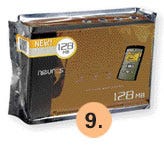 In what was most likely music to its ears, Hebron, KY-based converter Specialty Films & Associates, Inc., earned a silver award in packaging excellence for its creation of a side-gusset pouch for Digital Innovations' Neuros™ line of MP3 players (9). The semi-transparent, custom-metallized pouch duets with an SBS carton for a unique presentation. Says Robert Ormsbee, account manager for Specialty Films, "The customer wanted a different look from the norm to make its product stand out and increase shelf appeal."
In what was most likely music to its ears, Hebron, KY-based converter Specialty Films & Associates, Inc., earned a silver award in packaging excellence for its creation of a side-gusset pouch for Digital Innovations' Neuros™ line of MP3 players (9). The semi-transparent, custom-metallized pouch duets with an SBS carton for a unique presentation. Says Robert Ormsbee, account manager for Specialty Films, "The customer wanted a different look from the norm to make its product stand out and increase shelf appeal."
The pouch, which measures 7.87531634.25 in., is a partially metallized trilaminate made from a Vacumet-supplied film. Printed on the silvery, semi-transparent pouch are images of the MP3 player and descriptive, fine-point type that harmonize with the graphics and type printed on the inside carton. The film was reverse-gravure-printed on a Cerutti press in four process and three spot colors.
In addition to providing a distinctive, high-tech appearance, the metallized film pouch also allows for tamper-evidence, as it hermetically seals the inner package of expensive electronic components. A tear notch on one of the side gussets allows for access to the inner carton. Also noteable: the partially metallized substrate allows for dissipation of potentially damaging electrostatic discharge.
The pouches are premade by Specialty Films on Totani equipment before being supplied to International Precision Services, Melrose Park, IL, for filling. Circle No. 222.
User-friendly produce bag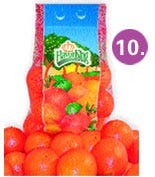 The Carry-Fresh® produce bag (10), developed by NNZ-the packaging network, is a consumer-friendly, visually high-impact way to brand and package consumer produce, foods and retail products. Utilizing a block-bottom, rectangular standup mesh pouch and a vibrantly printed front and back body label, Carry-Fresh has a multitude of superior attributes compared with traditional bulk consumer produce packages. It offers produce processors a way to enhance retail brand awareness with powerful graphics while consumers love its convenience and bold, colorful look. Carry-Fresh benefits have shown to increase sales and profits to processors and retailers alike.
The Carry-Fresh® produce bag (10), developed by NNZ-the packaging network, is a consumer-friendly, visually high-impact way to brand and package consumer produce, foods and retail products. Utilizing a block-bottom, rectangular standup mesh pouch and a vibrantly printed front and back body label, Carry-Fresh has a multitude of superior attributes compared with traditional bulk consumer produce packages. It offers produce processors a way to enhance retail brand awareness with powerful graphics while consumers love its convenience and bold, colorful look. Carry-Fresh benefits have shown to increase sales and profits to processors and retailers alike.
Dubbed the first fresh-produce package utilizing the increasingly popular block-bottom, rectangular standup pouch configuration, Carry-Fresh marries two unique materials: the mesh-film portion utilizes the proprietary CLAF cross-laminated PE open-mesh nonwoven fabric produced by Atlanta Nisseki CLAF Inc. CLAF exhibits superior strength and esthetics and machines like film on the Carry-Fresh vertical form, fill and seal machine used to produce these bags. The printed film-lamination label, which won silver awards for packaging excellence and technical innovation or North State Flexibles LLC, is bonded to the CLAF, and teams PP with a specifically formulated PE/metallocene blend to achieve maximum strength and aesthetics.
Finger holes in the top of the bag make it easy to carry. And it's strong–the combination of net-film and the film lamination creates a package that can hold even the heaviest of produce.
An excellent vehicle for branding, because it stands upright, the Carry-Fresh package creates a large billboard surface area for flexo-process- or gravure-printed graphics. The Flavor King citrus package produced by Premier Fruits & Vegetables BBL, Montreal, was flexo-printed in 10 colors. The two components of the bag–the strong, stable net film and the preprinted label front-and-back-film lamination–run on an automatic vertical form/fill/seal machine. Carry-Fresh is the logical next step in evolving retail produce from a crop to a branded product, PD is told. Packers are said to "love the efficiencies of the Carry-Fresh form/fill/seal machine," with its flexibility of changing designs and sizes. Circle No. 216.
Bag-in-box film Providing exceptional product evacuation from a bag-in-box structure, Rapak's EvacuFilm Bag-in-Box (11) won silver awards for both packaging excellence and technical innovation. With its embossed, laminated film structure, the two-ply film bag is a considerable improvement over the existing package, according to Rapak. It eliminates the need for tubes to be used in evacuating liquids from the bag and exhibits excellent abuse-resistant requirements for liquid filling and distribution.
Providing exceptional product evacuation from a bag-in-box structure, Rapak's EvacuFilm Bag-in-Box (11) won silver awards for both packaging excellence and technical innovation. With its embossed, laminated film structure, the two-ply film bag is a considerable improvement over the existing package, according to Rapak. It eliminates the need for tubes to be used in evacuating liquids from the bag and exhibits excellent abuse-resistant requirements for liquid filling and distribution.
Rapak experiences improved labor utilization, reduced waste and reduced raw material inventory, while foodservice customers realize full utilization of carbonated drink concentrate.The embossed flexible film, supplied by both Pechiney Plastic Packaging, Inc. and CTI Industries, helps create a more efficient, better-performing and ultimately, revenue-enhancing package.
This bag-in-box package utilizes a laminated triplex structure enhanced by an external blown-film layer that improves abuse-resistance. The core layer is oriented nylon, which adds strength. PE extrudate layers were optimized to allow an exact embossing pattern to be applied, creating a defined, controlled design on the internal blown sealant film. The specific embossed patterns and depth of detail are the key innovation. The embossing eliminates the need for an internal fitment tube to be placed through the entire bag to keep it from collapsing on itself. Embossed film also decreases the number of leakers, reducing defective product.
This package represents an embossed film created during the in-line lamination process, which utilizes an embossed chill roll to create the functional pattern. In other applications, the pattern is created off-line. The embossed film is efficient to use and carries associated cost savings. Contributing to those is a two-web versus four-web structure that also increases Rapak's efficiencies and lowers material waste and reduced raw material inventory.
Users experience increased utilization of the liquid concentrate product, translating into increased revenue, while Rapak says it experiences improved labor utilization. Customers reportedly experience reduced leaker rates and enhanced liquid output, Rapak says. Circle No. 214.
Single-serve lunchmeat packages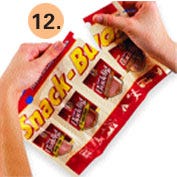 The convenient, single-serve Carl Buddig Snack Buds™ lunchmeat package (12) won a silver award for technical innovation. The new customer-generated innovation provides convenience in a single-serve lunchmeat format. The package's four perforated packets of meat can be pulled apart, and the contents can be made into a sandwich, a nutritious snack or eaten as a low-carbohydrate snack. There are two varieties in each package, such as Honey Ham and Honey Turkey. The idea was to generate a new product in the market that addresses the "on-the-go," portable trend. The package also addresses the needs of freshness, and equally important, prep time. The consumer simply separates the packages needed and puts the rest back in the refrigerator.
The convenient, single-serve Carl Buddig Snack Buds™ lunchmeat package (12) won a silver award for technical innovation. The new customer-generated innovation provides convenience in a single-serve lunchmeat format. The package's four perforated packets of meat can be pulled apart, and the contents can be made into a sandwich, a nutritious snack or eaten as a low-carbohydrate snack. There are two varieties in each package, such as Honey Ham and Honey Turkey. The idea was to generate a new product in the market that addresses the "on-the-go," portable trend. The package also addresses the needs of freshness, and equally important, prep time. The consumer simply separates the packages needed and puts the rest back in the refrigerator.
In effect, Snack-Buds creates a new product category of single-serve meat snacks, Curwood says. Consumers demand products that are convenient, portable, fresh and that save time.
The hermetically sealed modified-atmosphere package incorporates Curwood's new, unique, patent-pending film that utilizes a proprietary seven-layer ICE® coextrusion process that is unique to Curwood. The exact process is proprietary, the company states, but utilizes a rapid quench operation that results in the film having higher clarity, memory and a wide forming window after it goes through the ICE treatment process. The proprietary, seven-layer coextrusion includes PET, nylon, an ethylene vinyl alcohol (EVOH) core barrier layer and LLDPE. The outer PET layer provides stiffness to resist curling and acts as a high-impact printable exterior. Curwood has applied for a patent for this film development.
The multilayer nylon/polyester ICE film structure provides other advanced film characteristics, including extreme layflat properties, high clarity, excellent corner thickness and formability for critical draw thermoforming applications. It also contains exceptional formed pocket memory.
Curwood says ICE films can typically be formed at cooler temperatures than other films. Forming temperatures are reduced between 30 and 75 deg F, depending on the film being replaced and the type of packaging equipment used. It can also reduce wear and tear on packaging equipment, which lowers maintenance costs. The film also provides the package with significant oxygen barriers to extend shelf life as well as reduce potential leakers. The oxygen transmission rate is less than 0.2 ccs. The film also possesses excellent puncture-resistance and gloss.
Curwood's coextrusion process allows for the introduction of polyester into a nylon film, providing the ability to register-print the film. This new and innovative package eliminates the need for an adhesive label on nylon forming films, Curwood notes. Using this technology can lower reduce packaging costs because it eliminates the need for placement of adhesive labels ontaining nutritional information on the forming side of the package. The process also opens the doors to opportunities for additional register printing of polyester ICE films replacing traditional nylon forming films. Circle No. 218.
Laser-scored lunchmeat pack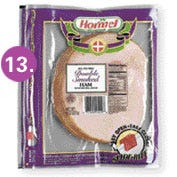 Convenience, security and reclosability are the beneficial results of an aligned laser-scoring technique from Pechiney called LaserTear,w a technology that creates easy-to-open tear lines set exactly to a manufacturers' specifications. The use of LaserTear allows Hormel to incorporate a slider zipper into its Premium lunchmeat pouches (13).
Convenience, security and reclosability are the beneficial results of an aligned laser-scoring technique from Pechiney called LaserTear,w a technology that creates easy-to-open tear lines set exactly to a manufacturers' specifications. The use of LaserTear allows Hormel to incorporate a slider zipper into its Premium lunchmeat pouches (13).
The unique laser-scoring method won Pechiney a silver in technical innovation. Hormel's eye-catching pouch holding 8 oz of product is a two-web, horizontal thermoform/fill/seal pack with a slider zipper attached through the addition of the aligned laser scores on the forming and nonforming films.
The package is described as having a five-layer coex forming web of nylon/adhesive/EVOH barrier/EVA sealant, that is sealed to a biaxially oriented nylon/EVOH/EVA sealant top web or lidstock. The slider profile, with its barrier track, is a five-layer EVOH-containing coextrusion. Pechiney laser scores both the nonforming and forming webs, in alignment, in the package's header area above the slider zipper closure.
Launched last summer, the sliced deli meats pack features Pactiv's Hefty® Slide-Rite® reclosure, and is said to be the first use of a slider closure on a package made on a horizontal tf/f/s machine (see PD, Dec. '03, p. 2). Intensive R&D went into the package's design, with its easy-to-use integral closure, that helps maintains the flavor and freshness of the meats, opening after opening, reseal after reseal.
Pechiney says the LaserTear scoring technology forms a directional score, either in a straight line or two-dimensionally, at a controlled depth. Capable of extremely tight tolerances, the score is virtually undetectable as the film is converted into a finished package, and becomes a precise tear path. An easy-pull in the score line triggers an accurate tear, which retains full functionality of the slider zipper.
"Hormel Foods adopted this closure to offer our premium deli meats in a package with both an unrivaled technical advantage and exceptional consumer convenience," states Dan Miller, manager of packaging development at Hormel Foods. "The package gives us a true marketing point of differentiation. Slider closures greatly ease access and resealing of the product... Because of its reliable features, we feel the new slider will be an industry standard in years to come."
The handy, leak-resistant package is the result of collaborative efforts by Hormel and Pechiney, which converts the forming and sealing webs, as well as Pactiv, which makes the roll-fed closure system, and equipment manufacturer Multivac, developer of the SR-2002 horizontal tf/f/s closure applicator that feeds the slider closure material to the flexible packaging material. Multivac customized one of its tf/f/s machines to both vacuum-pack the product and heat-seal the slider profile to the flexible package film. The dual applicator, which includes nonexclusive slider profile attachment equipment from Pactiv, forms the deli meat packages two-up with a below-the-track tamper-evident membrane that eliminates the need for a peel-seal. Circle No. 214.
Ritzy new pouch for chips A custom standup pouch for Ritz Chips, which won a silver award for technical innovation for Printpack, Inc. (14), represents the transition into an entire new package platform for Kraft Foods, and offers an innovative new format for the snack, cookie and cracker markets.
A custom standup pouch for Ritz Chips, which won a silver award for technical innovation for Printpack, Inc. (14), represents the transition into an entire new package platform for Kraft Foods, and offers an innovative new format for the snack, cookie and cracker markets.
The pouch's flat bottom and side gussets create a large top opening for consumption of the chips and incorporates a reclosable peel-tab that lends additional consumer convenience and facilitates portion control. The package also benefits from a proprietary sealant web that delivers a clean, easy-open peel function while achieving optimum package seal-integrity during pack off. A tandem adhesive-lamination structure exceeds the key attribute-requirements of high-impact graphics, product shelf-life barriers, high-speed machinability, and consumer functionality.
Beyond the unique structure, the development gives credit to the joint efforts that enabled a speed-to-market approach. The designers incorporated numerable vignette design elements that mandated gravure printing's inherent fine-screen capabilities, notes Printpack.
The custom package addresses key criteria–rigidity for shelf appearance, high-impact graphics, seal peelability for opening ease and proper machineability. Circle No. 223.
More information is available:
Awards program: Flexible Packaging Assn., 410/694-0800. www.flexpack.org. Circle No. 213.
Healthcare pouch, bag-in-box film, laser-scored lunchmeat pack: Pechiney Plastic Packaging, Inc., 773/399-8000.www.pechineyplasticpackaging.com. Circle No. 214.
Windowed chocolates pouch: Amcor Flexibles, 32 13 352599.www.amcor-flexibles.com. Circle No. 215.
Standup pouch for socks, produce bag: North State Flexibles, 336/544-4100.www.nstatepkg.com. Circle No. 216.
M-16 rifle bag: Heritage Packaging, 585/223-1336. www.heritagepackaging.com. Circle No. 224.
M-16 rifle bag: Valeron Strength Films, 713/462-6111.www.valeron.com. Circle No. 225.
Bone-guard protection bag, lunchmeat snack pack: Curwood, Inc., 920/303-7300.www.curwood.com. Circle No. 218.
Standup bag for chicken: Bemis Polyethylene Packaging Div., 812/460-6200.www.bemisppd.com. Circle No. 219.
Lipcolor sampler: American Packaging Corp., 585/254-9500. www.ampackcorp.com. Circle No. 220.
Ham shipping pouch: Exopack, LLC, 877/447-3539.www.exopack.com. Circle No. 221.
MP3 player pouch: Specialty Films & Associates, LLC, 859/647-4100. www.specialtyfilms.com. Circle No. 222.
Ritz chips pouch: Printpack, Inc., 404/691-5830.www.printpack.com. Circle No. 223.
About the Author(s)
You May Also Like


